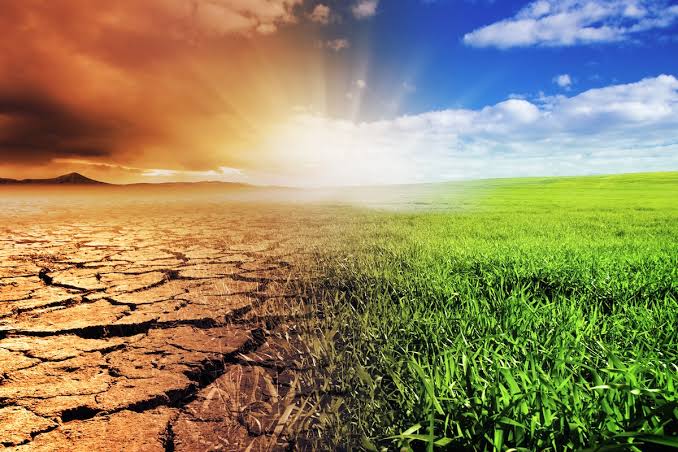Agriculture
Global Water Scarcity: The Interplay Of Climate Change And Agriculture -By Abachi Ungbo
According to the United Nation, water use has grown at more than twice the rate of population increase in the last century. By 2025, an estimated 1.8 billion will live in areas plagued by water scarcity with two-thirds of the worlds population living in water stressed regions as a result of use, growth and climate change.

Water for drinking, agriculture and other purposes is palpably at a premium as water bodies are shrinking at an alarming proportion which is an evident reality of climate change. Interestingly, aside being a victim of the climate change; agriculture has also assumed an active underlying factor in the increasing global water scarcity. Growing water scarcity is assuming a grave challenge for sustainable development and it is expected to intensify as a result of climate change.
The earth is floating on a massive body of water.
Understandably, it beggars belief especially by not a few, that water stress conditions or scarcity abounds in the face of the huge amount of water on the planet. However, it is instructive to point that about 70% of the earth surface is covered by water. And, 97% is found in the ocean where salinity makes it unfit for drinking and use for agriculture while 3% is fresh water with much hold up in the glaciers and snowfields.
Water is indispensable as the air we breathe; it means life. The human life and activities revolves around water. So the ubiquity of water does not mean availability. This is eloquently supported by the report – Progress on Drinking water and Sanitation (WHO/UNICEF 2019) stating that some 3 in 10 people worldwide or 2.1 billion do not have access to safe readily available water at home with 844 million of them lacking even a basic drinking water service. 159 million people still drink untreated water from surface water sources such as streams or lakes. 58% of them living sub Saharan Africa. According to the United Nation, water use has grown at more than twice the rate of population increase in the last century. By 2025, an estimated 1.8 billion will live in areas plagued by water scarcity with two-thirds of the worlds population living in water stressed regions as a result of use, growth and climate change. Again, it is reported that water withdrawals will increase by 50% by 2025 in developing countries and 18% in developed countries.
Climate change and agriculture are interrelated processes. Agriculture contributes to climate change through the emission of abundant greenhouse gases basically methane and nitrous oxide through farming. Methane is produced by livestock while nitrous oxides are product of organic and mineral nitrogen fertilizers. While, climate change is fast affecting agriculture in diverse ways through wide variations in average temperatures, rainfall and climate extremes (heat waves) change in pests and diseases, change in atmospheric carbon dioxide etc. So, climate change and agriculture are double whammy against water availability through changing patterns of precipitation and shrinking glaciers with damaging outcome of drought. And, studies states that Africa may lose 1-18% of its arable land area which put the poor at risk as a result.
The synthesis of the unremitting population growth which has been predicted to climb to a height of 9.7 billion by 2025 with climate change and increased agricultural production are actively contributing to scarcity and competition over water resources. The import of increase in agricultural production and by extension food security cannot be gainsaid. In meeting with the population growth; agricultural production will need to expand by approximately 70% in 2050 to cater for the population. This translates to a huge water demand to support the required growth of agriculture.
Agriculture has been described as both a victim and a cause of water scarcity. The international water management institute asserted that agriculture accounts for 70% of the global water withdrawals competing with domestic, industrial and environmental uses for a scarce water supply and it is expected to increase by a further 19% due to unsustainable irrigational activities. The use of irrigation remains the largest user of water globally and the irrigation water withdrawal normally far exceeds the net irrigation water requirement with the intensive ground water pumping depleting the aquifers. Data from a NASA programme shows that 21 of the 37 largest aquifers (57%) are running out too fast to be replenished. Worryingly, 13 are declining at a rate that puts them in a category NASA calls the “most troubled.
Nigeria is the 22nd least prepared country to deal with the impacts of climate by the Notre Dame Global Adaptation Index. The impact of climate change in the country is already being felt with average temperatures across the country rising with flooding, extreme heat and low precipitation engendering swift desert encroachment on significant agricultural land.
The Lake Chad is a convenient poster child of climate change. The Lake Chad has been dramatically transformed by the effects of climate change and unsustainable water management losing 90% of its surface area. Temperatures have risen higher than the global average with rainfall pattern increasingly erratic.
Author Steven Solomon in his book- Water: the Epic struggle for Wealth, Power and Civilization argued convincingly that just as wars over oil played a major role in 20th century history conflicts in the 21st century will be fought over water. The inefficient water use and the insidious effect of climate change may just bring it into fruition. The Nile river basin is shaping up for a grave spat between the Egyptians and the Ethiopians over the latter mammoth dam project which is meant to solve their chronic power problem. To the Egyptians the project poses a grave existential threat. It relies almost wholly on the Nile for 90% of its water resources and about 97% of Egyptians live along the banks of the Nile where the countrys most fertile farmlands exist. With low water levels, livelihood of farmers who depend on water for irrigation will be affected alongside the transport on the Nile. Piling on the agony of the Egyptians is the raging effect of climate change.
By 2030, the Dartmouth researchers wrote that the flow of the Nile will regularly fail to meet demand and between 20% and 40% of the population will face water scarcity; already, they have a surge in population to grapple with it. The Egyptians antsy was appropriately explained by the minister of water resources and irrigation that were responsible for a nation of about 100 million, he says. If the water thats coming to Egypt reduces by 2% we could lose about 200,000 acres of land. One acre at least makes one family survive. A family in Egypt is average family of about five persons so this means one million will be jobs.
There are no shortages of pathways in grappling with the topical problem. However, commitment to sustainable systems remains significant. Truth is, agricultural production need to move towards sustainable practices in the management of water through increasing overall efficiency of water by the sector to attenuate its impact on freshwater resources. Farmers will need to be assisted through appropriate policies, public and private investments, exposure to relevant knowledge and requisite resources to ratchet up production with less water.
ABACHI UNGBO
abachi007@yahoo.com




















